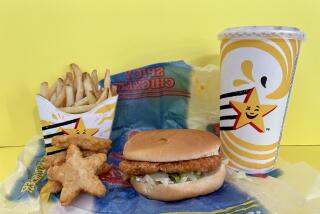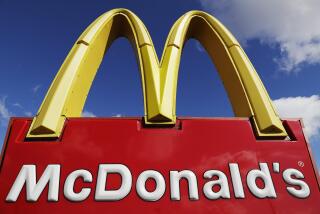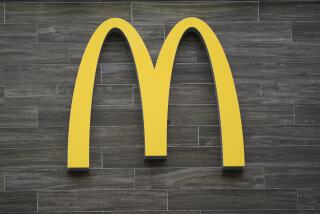Did Somebody Say Cheese?
The “We Love to See You Smile” advertising slogan that McDonald’s Corp. will unveil today just as easily could be aimed at shareholders who’ve found the company’s stock as alluring as a tub of cold French fries.
McDonald’s reportedly will spend $500 million on the ad campaign that features beaming employees who tell how freshly painted restaurants and state-of-the-art kitchens are making customers smile. But in an industry awash in fast-food alternatives, lines of happy customers are what Big Mac needs to turn investors’ frowns upside down.
“The issue troubling [Wall Street] is the company’s lack of top-line growth in the U.S.,” said Ron Paul, president of Technomic Inc., a Chicago-based consulting firm. “McDonald’s is one of the big brands in this country with tremendous long-term value that is in trouble because it’s not delivering top-line growth domestically.”
McDonald’s first-quarter numbers were solid, but sales stalled in May and some Wall Street analysts downgraded ratings. The company’s shares are hovering near a 52-week low of $29.81, which clearly frustrates the company.
“The stock always has come back,” said Jim Frisbie, a McDonald’s franchisee for 33 years who, along with four grown children, now owns 14 stores in Orange County. “And it’s going to come back again when Wall Street loses its fascination with technology stocks. You’ve got five families right here who are betting on that.”
Despite its sluggish share price, McDonald’s still dominates the fast-food restaurant row.
The Oakbrook, Ill.-based chain generated $1.95 billion of the $5.95 billion in 1999 net profit reported by the nation’s top 100 restaurant chains. Strong growth overseas helped to push systemwide sales to $38.5 billion in 1999, up from $29.9 billion in 1995.
A popular promotion--such as last year’s hot Teenie Beanie Babies collection--draws crowds, and McDonald’s has plenty of room to grow in the breakfast and dinner hours. McDonald’s also has expanded its restaurant collection to include Boston Market, Donatos Pizza and Chipotle Mexican Grills chains.
But McDonald’s executives and franchisees knew in 1998, when the chain lost domestic market share for the first time, that repairs were in order. During a subsequent restructuring, 500 corporate positions were eliminated. Longtime McDonald’s executive Jack Greenberg was named chairman and Alan D. Feldman took over as president of McDonald’s USA. Five division offices, including one in Irvine, were created to push decision-making closer to restaurant counters.
Franchises and corporate executives agree change was overdue.
“A few years ago, things were not wonderful,” said franchisee Isabelle Villasenor, who owns seven McDonald’s restaurants in Orange and Los Angeles counties. “Something needed to be done.”
Southern California operators began meeting to plot strategy. “We sat down in this big, humongous room,” Villasenor said. “But then we realized, ‘Why are we talking just to each other?’ We needed to be talking to customers.”
Operators soon were hip-deep in data generated by a string of focus groups. Customers told operators they wanted better service. Feldman, who on Thursday toured restaurants in Ontario, Tustin and Costa Mesa, said the chain listened: “Our goal is to provide the best service in the industry. We’ve made a tremendous amount of progress and we think now is the time to tell people about that.”
McDonald’s and its franchisees have installed new kitchens to cut waste and deliver hot, tasty food to consumers. New menu items, including the McFlurry dessert and the McSalad Shaker, seem to be satisfying consumers’ taste buds.
Restaurant crews use computerized displays to speed orders and ensure that disgruntled customers don’t stomp back in the door looking for missing cheeseburgers. Most restaurants have been repainted and refurbished. And franchisees say the division system makes it easier to introduce new items catered to regional tastes.
“We’re not just trying to get back to where we used to be,” said Scott Frisbie, who’s been working in his family’s restaurants for 25 years. “With the competitive nature of this industry, you need to be much better than we used to be.”
Restaurant industry observers say flashy advertising and whiz-bang technology alone won’t do the trick. An army of teens and senior citizens taking orders behind counters will have a tremendous say in McDonald’s future success.
“McDonald’s can’t just build consumer loyalty on branding,” said Tarun Kapoor, a professor at the Collins School of Hospitality Management at Cal Poly Pomona. “They have to build it on service orientation . . . they’ve got to convince that 16-year-old kid behind the counter that he’s selling something more than a burger.”
Villasenor agrees: “The only way it’s going to work is by putting smiles on both sides of the counter.”
The chain still has supporters on Wall Street. Merrill Lynch’s Peter Oakes, for example, stood by his buy recommendation after the May sales slump. But investors clearly are demanding more from such durable brands as McDonald’s and Procter & Gamble.
“The challenge for Alan is to come up with a home-run product or promotion--or at least a double,” Paul said.
“They’ve gone through a large process of reinvention in the past two years,” Kapoor said. “Now it’s time to go out and show some results.”
(BEGIN TEXT OF INFOBOX / INFOGRAPHIC)
A New Twist
McDonald’s latest advertising slogan is “We Love To See You Smile.” The accompanying advertising campaign will revolve around actual McDonald’s employees. McDonald’s also will unveil a new logo that blends the fast-food chain’s “M” logo with a stylized smile.
McDonald’s leads in market share ...
1999 figures
McDonald’s: 43.1%
Burger King: 19.6
Wendy’s: 12.3
Hardee’s: 4.9
Jack in the Box: 4.0
*
... and spends heavily to stay there ...
1999 advertising figures
McDonald’s: $623.6 million
Burger King: $400.4 million
Wendy’s: $217.2 million
McDonald’s Slogans Through the Years
1965: McDonald’s is Your Kind of Place
1971: You Deserve a Break Today
1975: We Do It All For You
1979: Nobody Can Do it Like McDonald’s Can
1981: You Deserve a Break Today
1983: McDonald’s and You
1984: It’s a Good Time, for the Great Taste of McDonald’s
1988: Good Time, Great Taste
1990: Food, Folks and Fun
1991: McDonald’s Today
1992: What You Want is What You Get
1995: Have You Had Your Break Today?
1997: Did Somebody Say McDonald’s?
2000: We Love to See You Smile
Sources: Technomic Information Services, Competitive Media Reporting, McDonald’s
More to Read
Inside the business of entertainment
The Wide Shot brings you news, analysis and insights on everything from streaming wars to production — and what it all means for the future.
You may occasionally receive promotional content from the Los Angeles Times.










